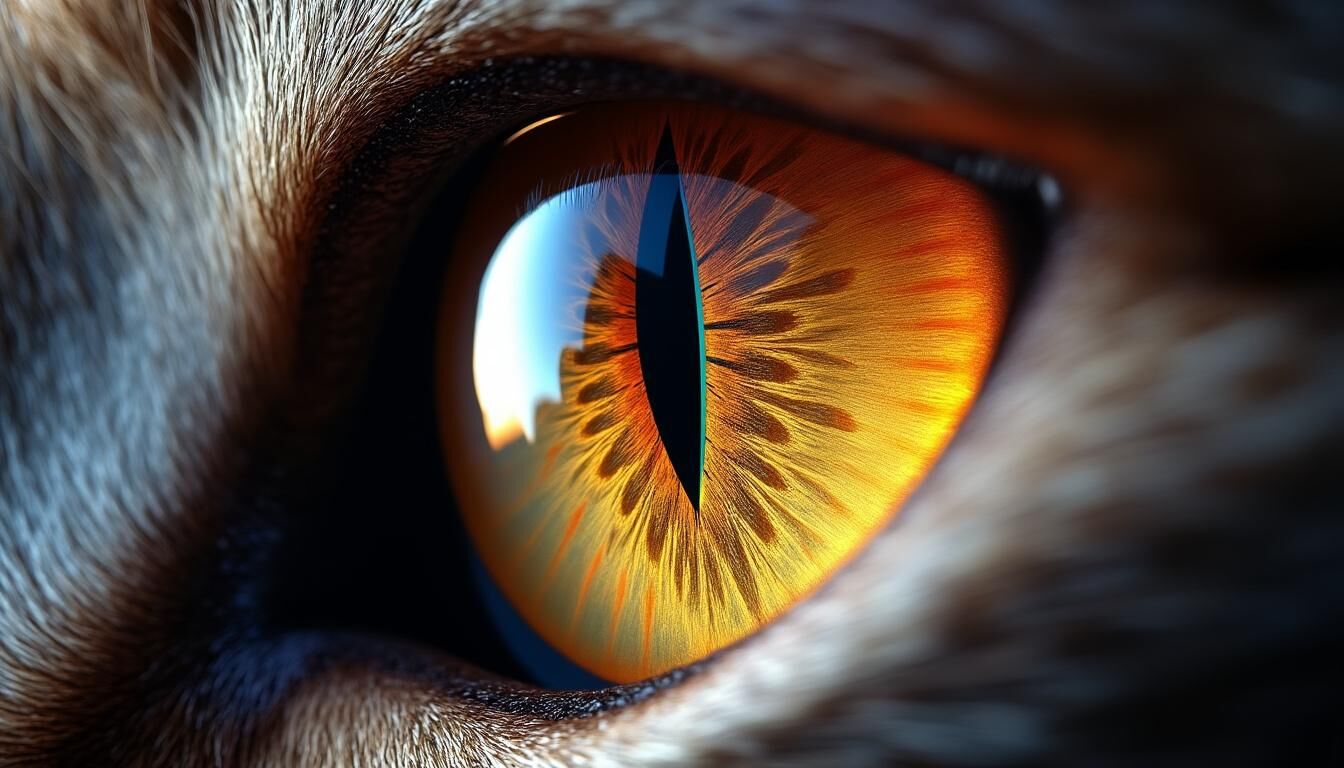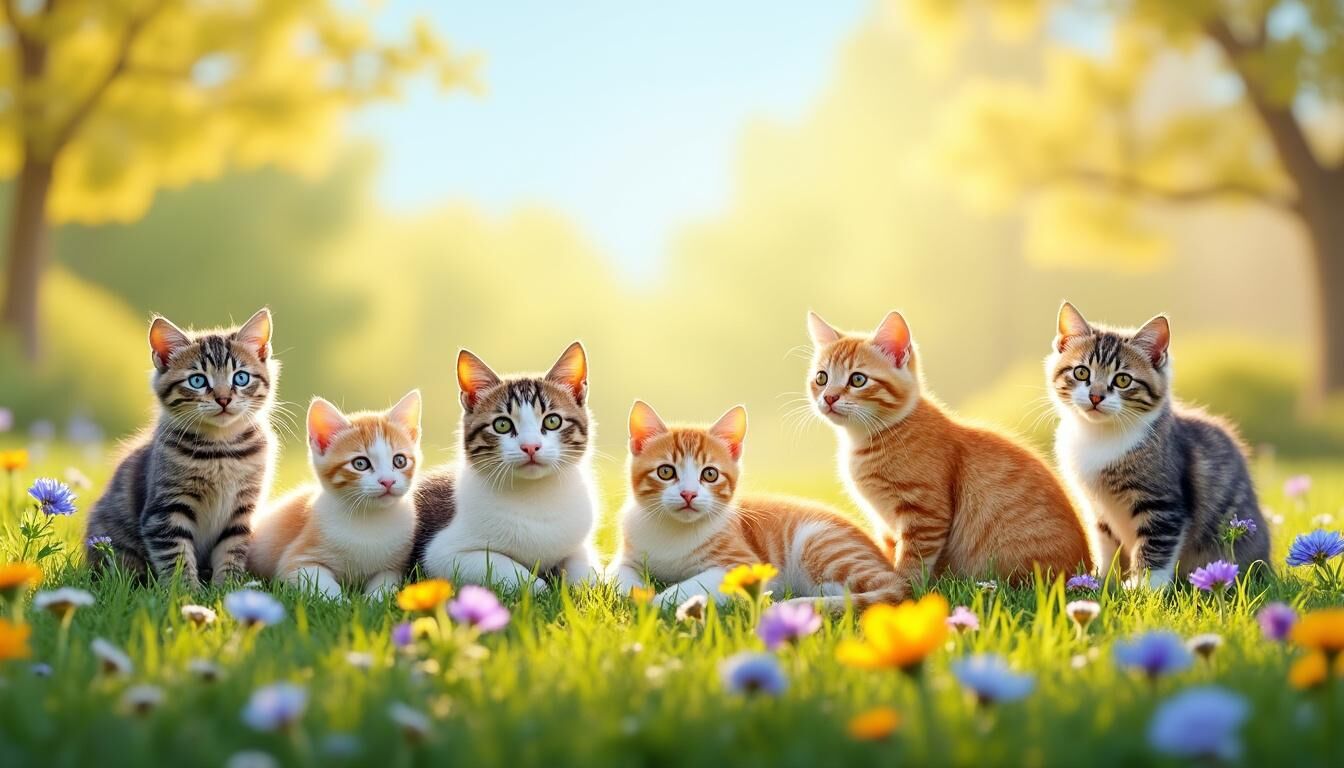Understanding what colors cats can see offers fascinating insights into the delicate balance between their evolutionary needs and sensory capabilities. Unlike humans, feline vision is specially tailored for hunting in dim light and detecting movement rather than experiencing a wide spectrum of vibrant colors. This adaptation has crafted a unique visual system where aspects like rods, the tapetum lucidum, and a distinctive retina structure play key roles. Exploring the anatomy and function of a cat’s eye reveals why their color sensitivity leans heavily toward blue and yellow shades, while the hues humans often favor, such as red and orange, appear muted or even invisible. These visual traits deeply influence feline behavior, especially in hunting and interaction with their environment, offering a window into the natural world through a cat’s perspective. This article dives into the science behind the feline eye and links anatomical features to everyday experiences with cats, shedding light on common myths and practical tips for owners seeking to enrich their pets’ lives.
How Cat Eyes Work: Anatomy and Essential Features of Feline Vision
Structure of the Cat’s Eye: Retina, Rods, and Cones
The anatomy of a cat’s eye is uniquely fashioned for optimal visual performance under a variety of light conditions. At its core is the retina, a thin tissue lining the back of the eye that contains photoreceptor cells, primarily rods and cones. While humans have roughly 6 million cones, which are responsible for processing color, cats possess far fewer, limiting their color discrimination but enhancing other visual elements.
Rod cells, far more abundant in feline retinas, excel at detecting low levels of light and motion. This heightened presence of rods allows cats to perceive movement even in near darkness — a vital skill for crepuscular hunters tracking elusive prey. The retina structure, combined with a vertical slit-shaped pupil, allows rapid adjustments in light intake, optimizing vision across variable light intensities.
Another defining trait is the tapetum lucidum, a reflective layer situated behind the retina that bounces light back through the photoreceptors. This biological mirror greatly enhances a cat’s night vision, allowing them to operate effectively in dim light settings where human vision would fail. It’s this feature that causes cats’ eyes to gleam vividly when caught in flashlight beams or car headlights, revealing an evolutionary advantage perfectly tailored for hunting under fading daylight or moonlight.
-
🐱 Retina: Contains rods and cones, crucial for vision and color perception.
-
🐱 Rods: Specialized for low-light sensitivity and motion detection.
-
🐱 Cones: Responsible for color vision, but fewer in number compared to humans.
-
🐱 Tapetum lucidum: Reflects light enhancing night vision.
-
🐱 Pupil shape: Vertical slits adjust precisely to light intensity.
|
Feature |
Function |
Effect on Vision |
|---|---|---|
|
Rods |
Detect dim light, movement |
Excellent night and motion vision 🌙 |
|
Cones |
Color perception |
Limited color with fewer cones than humans 🎨 |
|
Tapetum lucidum |
Reflects light to retina |
Enhances night vision greatly 🌓 |
|
Vertical pupil |
Controls light intake |
Sharp vision in varied light 🌞🌜 |
The Role of Cone Cells in Cat Color Perception
In feline vision, cone cells provide limited but essential color detection. Unlike humans who have three types of cones sensitive to red, green, and blue wavelengths, cats generally possess two types, making them dichromatic. This restricts their ability to see the wide array of colors that humans enjoy, but it aligns well with their survival needs.
Specifically, cat cones exhibit higher sensitivity to blue and possibly some green wavelengths, while colors like red and orange, important for humans’ vibrant palette, are almost nonexistent in their visual experience. This explains why feline color vision emphasizes contrasts created by blue and yellow tones rather than the full spectrum.
-
🔵 Cats have mostly two types of cones (dichromatic vision).
-
🔵 Strong sensitivity to blue and some green light.
-
🔵 Limited or no detection of red and orange wavelengths.
-
🔵 Cones contribute mainly in daylight or well-lit conditions.
Understanding this system clarifies why cats often neglect red toys and objects in favor of toys in shades of blue or yellow, which naturally attract their attention.
Rods, Tapetum Lucidum, and the Power of Low-Light Vision
The true strength of feline vision lies in the abundance of rods, cells that perceive light intensity rather than color. These enable cats to excel in low-light or twilight environments—conditions in which most humans struggle.
The tapetum lucidum acts as a natural amplifier by reflecting light back onto the retina and increasing sensitivity. This adaptation is crucial because it doubles the chance that a photon of light will stimulate the rods, thus boosting night vision. When combined with the cat’s slit-shaped pupils that widen or narrow according to ambient light, this system perfectly equips cats for hunting in dim light.
-
🌒 Abundance of rod cells helps detect minimal light.
-
🌒 Tapetum lucidum reflects light to improve sensitivity.
-
🌒 Vertical slit pupils optimize light flow into the eye.
-
🌒 Superior motion detection even at night.
|
Component |
Role in Vision |
Benefit for Cats |
|---|---|---|
|
Rods |
Light sensitivity |
Enables seeing in dim light and detecting movement 🐾 |
|
Tapetum Lucidum |
Reflects light |
Boosts night vision; causes eye glow ✨ |
|
Vertical pupil |
Light regulation |
Adjusts instantly for bright/dark environments 🌞🌛 |
What Colors Can Cats See? Comparing Cat and Human Color Vision
Dichromatic Vision Explained: Blues, Yellows, and Muted Colors
Cats possess dichromatic vision, meaning they see primarily through two color channels, a stark contrast to the trichromatic vision of most humans. This restricts feline color perception largely to blue and yellow shades, making other colors appear dull or muted.
Interestingly, many greens may also be detected, but their brightness and clarity are not as pronounced as in human vision. The color world of a cat is less vivid, with rich reds, oranges, and pinks shifting toward muted grays or brownish tones. This dichromacy is common among many mammals adapted to hunting in environments with varied light conditions rather than colorful displays.
-
🔵 Blue is one of the clearest colors for cats.
-
🟡 Yellow hues can be distinguished but with less vibrancy.
-
🟢 Some green shades may be perceived but not sharply.
-
⚪ Other colors appear muted or grayish, especially reds.
Such color limitations do not hinder cats because their vision was never designed for the same purposes as humans’; instead, it balances the need for prey detection and survival.
Why Cats Can’t See Red: Color Blindness Versus Human Vision
The inability of cats to perceive red hues is comparable to how some humans experience red-green color blindness, but it’s a natural and permanent aspect of feline vision. Humans have photoreceptors specifically tuned for red and green, while cats lack these.
This absence means that colors like red, orange, or pink blend into a less distinct backdrop, often resembling dull brown or gray instead of vibrant chromatic tones. While some humans require special glasses to aid their red-green color blindness, cats experience this as a normal part of how they see the world.
-
🔴 Cats lack the cones required to detect red wavelengths.
-
❌ Red objects may appear gray or brownish to their eyes.
-
⚠️ This is different from color blindness; it’s an inherent trait.
-
✅ Cats’ vision is optimized for other attributes besides broad color range.
This is why toys designed in red hues often fail to capture a cat’s interest.
How Colors Appear to Cats: Vividness, Contrast, and Common Myths
There’s a widespread myth that cats see in black and white, but this is far from the truth. Their color vision, while limited, is present and functional, especially toward certain wavelengths.
Colors appear less vivid to cats because of the reduced number of cone cells and the dominance of rods in their vision. Rather than seeing a vibrant rainbow, felines experience a palette skewed toward blues and yellows, set against shades of gray. Contrast is more critical to them than color saturation; strong visual boundaries and movement catch their attention much sooner than hue variations.
-
🐈 Cats see some colors but with less vibrance than humans.
-
🌈 Their visual emphasis is on brightness and contrasts.
-
🌟 Movement and edges are more prominent than color differences.
-
❌ They do not perceive pure black and white; color vision is present but limited.
|
Color |
Appearance to Cats |
Human Comparison |
|---|---|---|
|
Blue |
Bright and clearly visible 🔵 |
Same as humans |
|
Yellow |
Visible but less vivid 🟡 |
Less intense than humans |
|
Green |
Faintly perceived 🟢 |
Dull or muted |
|
Red/Orange |
Dull gray or brown ⚫ |
Vivid and saturated |
Feline Color Vision and Behavior: Impacts on Hunting, Play, and Survival
How Limited Color Vision Affects Cat Hunting and Survival Instincts
The feline eye’s prioritization of light sensitivity over color detail is a clear reflection of their evolutionary path as hunters. Limited color vision does not hinder a cat’s ability to detect prey; instead, it sharpens other visual faculties vital for survival.
For instance, cats rely heavily on detecting contrasting movement against a variable background rather than the color of the prey. In low light, where the color becomes irrelevant, their rod-dominated retinas excel. This feature aids in stalking and pouncing without relying on color cues.
-
🎯 Motion detection is key for hunting success.
-
🔦 Ability to see in dim light helps track nocturnal prey.
-
👁️ Limited color vision does not impair focus on brightness contrasts.
-
🐀 Precise vision supports survival over a broad range of environments.
Supporting a cat’s natural instincts involves recognizing how their visual world differs from that of humans, which includes understanding the limitations of their color perception during hunting or play.
The Importance of Motion Detection and Night Vision in Cats
Besides color, cats’ keen sensitivity to movement is one of their most remarkable visual traits. This ability, complemented by the tapetum lucidum, allows them to excel in detecting even subtle shifts in their environment after dusk.
Their pupils’ capacity to dilate widely and adjust rapidly makes their night vision superb, allowing cats to negotiate and react quickly to moving objects that might go unnoticed by humans. This specialized adaptation compensates for their muted color sensitivity and ensures efficient interaction with their surroundings at various times of day.
-
👀 Motion sensitivity detects prey or danger effectively.
-
🌙 Night vision enhanced by tapetum lucidum aids crepuscular activity.
-
🔆 Pupil control manages incoming light and optimizes focus.
-
🔄 Instant visual adaptation supports survival and play.
Practical Implications: Choosing Cat Toys and Accessories for Their Vision
Recognizing cats’ limited but specific color vision helps owners make better choices when selecting toys and accessories. For example, cats respond more readily to toys in blue and yellow shades — colors that stand out within their visual range.
Conversely, red or orange toys are less visually stimulating to them, which may explain why some cat owners notice their pets ignore these colors. This insight can dramatically enrich feline engagement and play, contributing to their mental and physical well-being.
-
🎾 Opt for toys in blue or yellow to capture attention.
-
🧸 Avoid red or orange toys that may seem dull.
-
🟦 Choose accessories with high-contrast patterns to stimulate vision.
-
🏡 Customize the environment to align with cats’ visual strengths.
Evolution, Adaptations, and Variations in Cat Color Perception
Evolutionary Adaptations: Crepuscular Life and Visual Strengths
The evolution of feline vision is deeply connected to their crepuscular lifestyle, active mostly during dawn and dusk when light is scarce. Their eyes evolved to emphasize high light sensitivity and motion detection over expansive color recognition.
The vertical pupil, enhanced rod density, and tapetum lucidum are all adaptations that support this niche. This evolutionary pathway optimized cats for stealthy hunting when shadows rule and colors merge into the background.
-
🌅 Crepuscular activity drives specialized vision.
-
👁️ Emphasis on brightness and motion over color fidelity.
-
🦴 Pupil shape and retinal structure tuned to low-light hunting needs.
-
🕵️♂️ Visual strengths favor survival and prey capture in challenging light.
Scientific Insights: Possible Variations and the Impact of Age or Health
Scientific investigation into feline eyes continues to reveal nuances. While the consensus confirms cats’ dichromatic vision, some studies hint at potential minor variations in cone types, but these do not drastically alter overall color perception.
Age and health may affect visual sharpness and clarity—cataracts or retinal diseases can reduce effectiveness, yet the fundamental dichromatic vision remains consistent throughout a cat’s life unless severe pathological changes occur.
|
Factor |
Impact on Vision |
Notes |
|---|---|---|
|
Age |
Possible reduced acuity |
Common in older cats but color range unchanged 🐱🦳 |
|
Health |
Retinal/ocular diseases affect clarity |
May impair vision but not color sensitivity fundamentally ⚠️ |
|
Cone variation |
Minor, debated |
No significant change to dichromatic pattern 🔬 |
Enhancing the Human-Cat Bond Through Understanding Feline Vision
Knowledge of how cats perceive the world visually offers practical benefits in deepening the human-animal relationship. By recognizing their visual environment is centered less on color and more on contrasts and motion, owners can tailor playtime, feeding, and habitat structures to suit their pets’ natural tendencies.
For instance, selecting toys from the right color shades and avoiding stimuli that do not register well, like certain red hues, enhances engagement. Moreover, appreciating the role of night vision and motion detection encourages owners to consider lighting and space layout, creating safe and stimulating homes for their felines.
-
🏡 Use knowledge of feline color vision when choosing toys, like those found in behavioral breed quizzes.
-
💞 Adjust play environments to emphasize movement and contrast.
-
✨ Avoid harmful household products; awareness of feline vision complements health care, such as avoiding scented products discussed in toxicity advisories.
-
🔄 Foster daily activities that resonate visually with cats for better enrichment.

FAQ
-
Can cats see colors in the dark?
While cats have superior night vision due to abundant rods and the tapetum lucidum, color vision is poor in low-light conditions. They mostly detect shapes and movement, not distinct colors when it’s dark. -
Are cats completely color blind?
No, cats are not color blind but have dichromatic vision, which limits their spectrum mainly to blue and yellow. They cannot see the full range of colors humans can. -
Why don’t cats like red toys?
Because feline eyes have low sensitivity to red wavelengths, red toys often appear dull or grayish to cats, making them less interesting compared to toys in blue or yellow shades. -
Does age affect a cat’s color vision?
Aging can reduce visual intensity or sharpness but does not significantly change the fundamental restricted color perception of cats. -
How can I choose the best environment for my cat’s vision?
Select toys and accessories in blue and yellow shades, use areas with variable but not harsh lighting, and provide plenty of opportunities for movement-based play to align with their visual strengths.

